National Gallery of Victoria, Melbourne
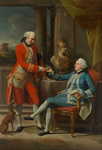
Sir Sampson Gideon and an unidentified companion , Pompeo Batoni
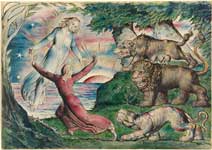
Dante running from the three beasts, William Blake

Antaeus setting down Dante and Virgil in the Last Circle of Hell, William Blake

St Peter and St James with Dante and Beatrice, William Blake
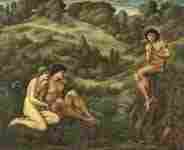
The garden of Pan, Edward Burne-Jones
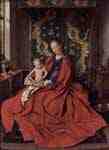
Madonna with reading Child, Jan van Eyck
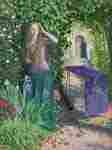
Fair Rosamund, Arthur Hughes
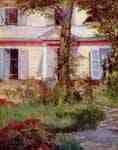 House in Rueil, Edouard Manet
House in Rueil, Edouard Manet

The pioneer, Frederick McCubbin
 The crossing of the Red Sea, Nicolas Poussin
The crossing of the Red Sea, Nicolas Poussin
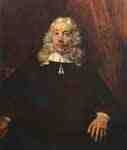 Portrait of a blond man, Rembrandt Harmensz. van Rijn
Portrait of a blond man, Rembrandt Harmensz. van Rijn

Anguish, August Friedrich Schenck
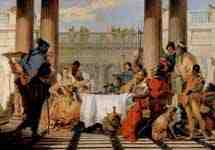
The Banquet of Cleopatra, Giovanni Battista Tiepolo

Mother and child, Cornelis de Vos

Ulysses and the Sirens, John William Waterhouse

Self-portrait as David with the head of Goliath, Johann Zoffany

Flower Still-Life, Jan Frans van Dael
Fine Art Prints | Greeting Cards | Phone Cases | Lifestyle | Face Masks | Men's , Women' Apparel | Home Decor | jigsaw puzzles | Notebooks | Tapestries | ...
The National Gallery of Victoria, popularly known as the NGV, is an art museum in Melbourne, Australia. Founded in 1861, it is the oldest public art museum in Australia. The NGV operates across two sites: NGV International, located on St Kilda Road in the heart of the Melbourne Arts Precinct of Southbank, and The Ian Potter Centre: NGV Australia, located nearby at Federation Square. The St Kilda Road building, designed by Sir Roy Grounds, opened in 1968, and was renovated by Mario Bellini and reopened in 2003. The Ian Potter Centre: NGV Australia was designed by LAB Architecture Studio and opened in 2002.[1]
History
The NGV was founded in 1861. Victoria had been an independent colony for only ten years, but in the wake of the Victorian gold rush, it was the richest colony in Australia, and Melbourne was the largest city in Australia. In addition to donations of works of art, donated funds from wealthy citizens have been used by the NGV to purchase Australian and international works by both old and modern masters. The NGV currently holds over 70,000 works of art.[2] The Felton Bequest, established by the will of Alfred Felton in 1904, has purchased over 15,000 works of art for the NGV.[3]
The National Gallery of Victoria Art School, associated with the gallery, was founded in 1867. It was the leading centre for academic art training in Australia until about 1910.[4] The School’s graduates went on to become some of Australia’s most significant artists.
Australian Collection
Frederick McCubbin, The pioneer, 1904
The NGV's Australian art collection encompasses Indigenous (Australian Aboriginal) art and artefacts, Australian colonial art, Australian Impressionist art, 20th century, modern and contemporary Australian art.
In the late 19th and early 20th century, domestic art began to thrive (particularly with the Heidelberg School in what was then an outer suburb of Melbourne) and the NGV was well-placed to add an excellent collection of key Australian works, which trace the metamorphosis of imported European styles into distinctively Australian art. The NGV houses many of the most recognisable Australian paintings, including Frederick McCubbin's The Pioneer and Tom Roberts' Shearing the Rams.
The Australian collection includes works by Charles Blackman, John Brack, Arthur Boyd, Louis Buvelot, Rupert Bunny, Nicholas Chevalier, Charles Conder, David Davies, William Dobell, Russell Drysdale, E. Phillips Fox, John Glover, Eugene von Guerard, Hans Heysen, George W. Lambert, Sydney Long, John Longstaff, Frederick McCubbin, Sidney Nolan, John Perceval, Margaret Preston, Hugh Ramsay, Tom Roberts, John Russell, Grace Cossington Smith, Arthur Streeton, Fred Williams and others.
A large number of works were donated by Dr. Joseph Brown in 2004 which form the Joseph Brown Collection.
International Collection
The NGV has an encyclopaedic collection of art. In addition to the Australian collections, international collection areas include European painting (historical and modern), fashion and textiles, photography, prints and drawings, Asian art, decorative arts, Mesoamerican art, Pacific art, sculpture, antiquities, and contemporary art. It has strong collections in areas as diverse as old masters, Greek vases, Egyptian artifacts and historical European ceramics, and contains the largest and most comprehensive range of artworks in Australia.[5]
The international collection includes works by Bernini, Bordone, Canaletto, Cézanne, Constable, Correggio, Degas, van Dyck, Gainsborough, Gentileschi, El Greco, Manet, Memling, Modigliani, Monet, Picasso, Pissarro, Poussin, Rembrandt, Renoir, Ribera, Rodin, Rothko, Rubens, Tiepolo, Tintoretto, Turner, Uccello, Veronese, and other masters.[5]
In 2011 the NGV celebrated its 150th birthday and acquired a highly important masterpiece by Correggio, one of the most influential figures of the Italian High Renaissance. The work, titled Madonna and Child with infant Saint John the Baptist, was painted circa 1514–15. The painting was purchased at Sotheby's London for $5.2 million and is the single highest priced acquisition in the NGV's history.[6]
Photography Collection
In 1967, the NGV established the first curatorial department dedicated to photography in an Australian public gallery.[7] It now holds over 15,000 works. In that same year, the Gallery acquired the photography collection’s first work, Surrey Hills street 1948 by David Moore[1] and in 1969 the first international work was acquired, Nude 1939 by František Drtikol[2]. The first photographer to exhibit solo at the NGV was Mark Strizic in 1968[8][3].
Selections from the permanent collection
Note that other notable works are in the collection but the following examples are ones in the public domain and for which pictures are available.
As a "National Gallery"
National Gallery Of Victoria (NGV)
The world's largest stained-glass ceiling in the NGV's Great Hall, designed by Australian artist Leonard French[9]
The view looking south towards the entrance to the NGV
Grimwade gardens, ground level of NGV
For some people the name "National Gallery of Victoria" is contentious as it is sometimes confused with the National Gallery of Australia (NGA) in Canberra, and there have been calls for the NGV to be renamed. However, the NGV was founded some 40 years before the formation of the Commonwealth of Australia, when Victoria was a self-governing British colony and a discrete political entity. It was also established more than a century before the NGA. According to former Victorian Premier Steve Bracks, "We won't be renaming the National Gallery of Victoria. It has a great tradition. It is the biggest and best gallery in the country and it's one of the biggest and best in the world."
Ian Potter Centre and NGV International
In 1959, the commission to design a new gallery and cultural centre was awarded to the architectural firm Grounds Romberg Boyd. In 1962, Roy Grounds split from his partners Frederick Romberg and Robin Boyd, retained the commission, and designed the gallery at 180 St Kilda Road (now known as NGV International). The building was completed in December 1967[10] and opened on 20 August 1968. One of the features of the building is the Leonard French stained glass ceiling, one of the world's largest pieces of suspended stained glass, which casts colourful light on the floor below. The water-wall entrance is another well-known feature of the building. Grounds subsequently designed the adjacent Victorian Arts Centre with its iconic spire.
The NGV is now spread over two buildings a short distance from each other at the southern end of the CBD. The Ian Potter Centre: NGV Australia, in Federation Square opened in 2003 and houses the Australian art collection. Grounds' building, just south of the Yarra River, houses the international collection. It reopened in December 2003 after four years of renovations by architect Mario Bellini. The iconic Angel sculpture by Deborah Halpern was restored and was relocated to Birrarung Marr.
Picasso theft
Main article: Theft of The Weeping Woman from the National Gallery of Victoria
A famous event in the history of the gallery was the theft of Pablo Picasso's painting "The Weeping Woman" in 1986 by a person or group who identified themselves as the "Australian Cultural Terrorists". The group took the painting to protest the perceived poor treatment of the arts by the state government of the time and sought as a ransom the establishment of an art prize for young artists. The painting was returned in a railway locker two weeks later.[11]
Melbourne Winter Masterpieces
The National Gallery of Victoria has held several large exhibitions known as Melbourne Winter Masterpieces exhibitions, starting with Impressionists: Masterpieces from the Musee d'Orsay in 2004, and an exhibition of Dutch masters in winter 2005 with Vermeer's painting The Love Letter from the Rijksmuseum in Amsterdam exhibited among many others. It was the first time a Vermeer painting had been exhibited in Australia. There was also an exhibition of Caravaggio paintings in 2004.
The 2006 Melbourne Winter Masterpieces exhibition was titled Picasso: Love and War 1935-1945 and ran from 30 June 2006 and 8 October 2006. The exhibition of over 300 Picasso drawings and paintings from the years 1935-1945 was curated by Anne Baldassari, Director of the Musée Picasso, Paris.[12]
The 2007 Melbourne Winter Masterpieces exhibition was titled "Guggenheim Collection 1940s to now" (30 June to 7 October 2007) and showed more than 85 works by 68 artists, mainly from the Solomon R. Guggenheim Museum, New York City, but also from other Guggenheim Museums in Venice, Bilbao, and Berlin. The exhibition did not travel to any other city; it was seen by more than 180,000 visitors.[13][14]
The 2008 Melbourne Winter Masterpieces exhibition was titled "Art Deco 1910—1939" and ran from 28 June to 5 October 2008. The exhibition was organized by the Victoria and Albert Museum, London.[15]
The 2009 Melbourne Winter Masterpieces exhibition was titled "Salvador Dalí Liquid Desire" and ran from 13 June to 4 October 2009.[16]
The 2010 Melbourne Winter Masterpieces exhibition was "European Masters: Städel Museum, 19th-20th Century".
The 2011 Melbourne Winter Masterpieces exhibition was titled "Vienna Art and Design" and ran from 13 June to 4 October 2011.[17]
The 2012 Melbourne Winter Masterpieces exhibition was "Napoleon: Revolution to Empire".
In 2013, the Melbourne Winter Masterpieces exhibition was "Monet's Garden: The Musee Marmottan Monet, Paris" which ran from 10 May to 8 September and attracted over 342,000 visitors.
In 2014, the NGV will showcase "Italian Masterpieces from Spain's Royal Court, Museo del Prado" as part of the Melbourne Winter Masterpieces series, from 16 May to 31 August.
NGV Triennial
In 2013 the NGV launched "Melbourne Now", an exhibition which celebrated the latest art, architecture, design, performance and cultural practice to reflect the complex cultural landscape of creative Melbourne. "Melbourne Now" ran from 22 November 2013 - 23 March 2014 and attracted record attendances of 753,071.[18] Following the success of "Melbourne Now", in March 2–14 the NGV announced a major new initiative, the NGV Triennial. Beginning in the Summer of 2017 and to be held every three years, this ambitious event will be a large-scale celebration of the best of contemporary international art and design.[19]
Directors of the NGV
Directors of the NGV since its inception:[20]
G. F. Folingsby, 1882–91
Lindsay Bernard Hall, 1891–35
William Beckwith McInnes, (acting) 1935–36
P. M. Carew-Smyth, (acting) 1937
J. S. Macdonald, 1936–41
Sir Ernest Daryl Lindsay, 1942–55
Eric Westbrook, 1956–73
Gordon Thomson (administrator), 1973–74
Eric Rowlison, 1975–80
Patrick McCaughey, 1981–87
Rodney Wilson, 1988
James Mollison, AO, 1989–95
Timothy Potts, 1995–98
Gerard Vaughan, 1999–2012
Tony Ellwood, 2012–
References
"NGV > Visit > Planning Your Visit > Visitor FAQs". Ngv.vic.gov.au. Retrieved 2013-08-15.
NGV Annual Report 2011 PDF
"NGV Media | Welcome to NGV Media". Ngv.vic.gov.au. Retrieved 2013-08-15.
McCulloch, Alan; Susan McCulloch (1994). The Encyclopedia of Australian Art. Allen & Unwin. p. 864 (Appendix 8). ISBN 1-86373-315-9.
"Collection Online > collections > Collection Areas". Ngv.vic.gov.au. 2013-07-31. Retrieved 2013-08-15.
"NGV Media | Welcome to NGV Media". Ngv.vic.gov.au. Retrieved 2013-08-15.
Although the Art Gallery of South Australia began collecting photographs as fine art in 1922, it houses them with 'Australian Prints, Drawings and Photographs'(see: http://www.artgallery.sa.gov.au/agsa/home/Collection/australlian_prints_drawings_and_photographs.html). Other Photography collections in public galleries are: The Art Gallery of New South Wales, est.1975 (see: http://www.artgallery.nsw.gov.au/collection/photography/); Queensland Art Gallery | Gallery of Modern Art (QAGOMA) started their collection in 1987 where works are housed as art of the Contemporary Australian Art collection
Mark Strizic: A Journey in Photography information National Portrait Gallery Travelling Exhibitions site http://www.portrait.gov.au/site/exhibition_subsite_strizic4.php
Shmith, Michael (30 November 2003). "Raising the roof with a glass ceiling", The Age. Retrieved 2 December 2012.
Green, Louise McO. "NGV Women's Association History". National Gallery of Victoria. Archived from the original on 2007-08-30. Retrieved 2007-12-22.
Justin Murphy; Susan Cram (19 September 2004). "Stolen Picasso". Rewind (ABC TV). Australian Broadcasting Corporation. Retrieved 10 September 2010.
"Arts Victoria - Melbourne Winter Masterpieces".
"Guggenheim Collection: 1940s to Now". NGV. 2007. Archived from the original on 2007-09-27. Retrieved 2007-10-10.
"Guggenheim leaves Melbourne". Entertainment Depot, Australia. 8 October 2007. Retrieved 2007-10-10.
"Art Deco". NGV. 2008. Retrieved 2009-06-10.[dead link]
"Salvador Dalí". NGV. 2009. Retrieved 2009-06-10.[dead link]
"Vienna". NGV. 2011. Retrieved 2011-06-10.
"NGV Media". NGV. 2014. Retrieved 2014-04-23.
"NGV Media". NGV. 2014. Retrieved 2014-04-23.
Alan McCulloch, Susan McCulloch and Emily McCulloch Childs, The New McCulloch's Encyclopedia of Australian Art (4th edition), Aus Art Editions & Miegunyah Press, 2006, p. 458.
----
Fine Art Prints | Greeting Cards | Phone Cases | Lifestyle | Face Masks | Men's , Women' Apparel | Home Decor | jigsaw puzzles | Notebooks | Tapestries | ...
----
Artist
A - B - C - D - E - F - G - H - I - J - K - L - M -
N - O - P - Q - R - S - T - U - V - W - X - Y - Z
Retrieved from "http://en.wikipedia.org/"
All text is available under the terms of the GNU Free Documentation License



